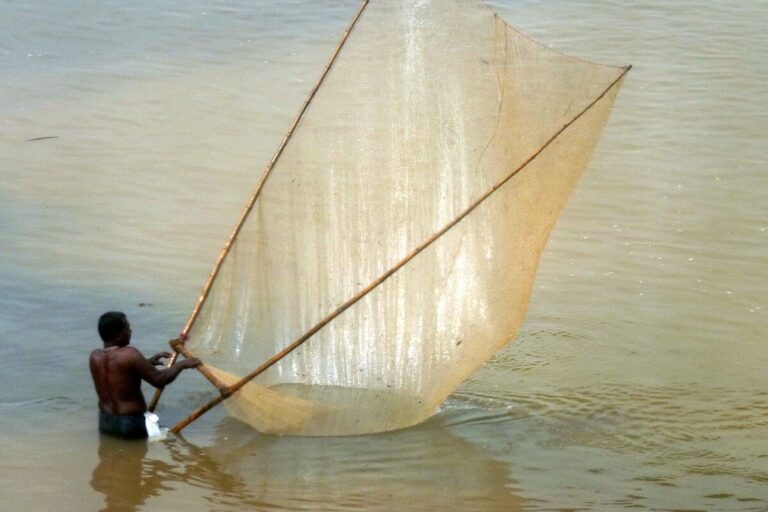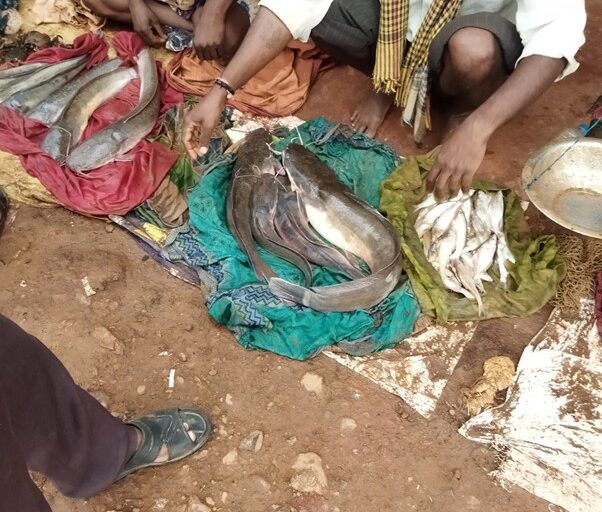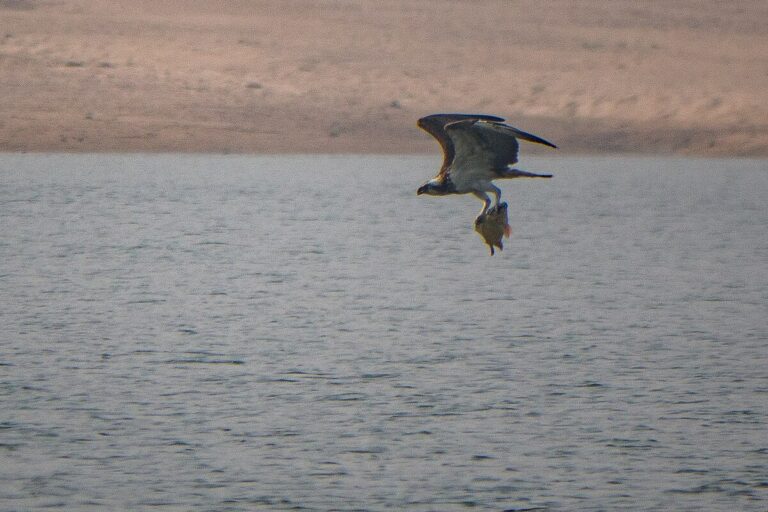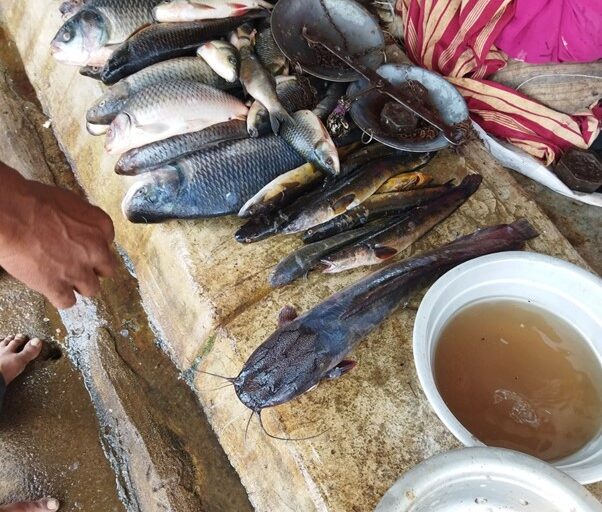African catfish are caught from rivers as bycatch and sold alongside other fishes in riverside fish markets in Kaveri and Tungabadra. Photo by Gopi Krishnan.
- Many of India’s aquatic ecosystems have invasive fish species introduced for various purposes in the past.
- These invasive fish species compound the challenges faced by declining aquatic biodiversity, posing threats to the ecological balance and the livelihoods of communities dependent on these ecosystems.
- Addressing this issue requires coordinated collective action, encompassing robust policies, extensive research, and collaborative efforts among multiple agencies.
During one of our research field trips to the Tungabhadra reservoir near Hampi, to study aquatic biological invasions, we asked a local resident, Sreenivasan, about the presence of the African catfish in the river. He replied with a smirk, “Yes, we see them all the time! It has been about 15 years now.” What struck us was that Sreenivasan used to be a fisherman and had shifted from fishing to driving an auto-rickshaw to make ends meet. The diminishing profitability of fishing due to reduced catch yields and increased competition had led to this transition.
This was one of many similar stories from other areas that were once bountiful with opportunities for the local fisherfolk. The decline in native fish species can be attributed to multiple factors such as habitat modification, pollution, overfishing as well as the lesser-discussed invasive species in aquatic systems.
While the term invasive species evokes a sense of unwelcome intruders, the reality is complicated. Many of these species were deliberately introduced for specific purposes. Take, for instance, the African catfish and Tilapia, which were introduced for aquaculture. Similarly, the South American armoured sailfin catfish or the tank-cleaner, found its way into households as an aquarium fish and Gambusia was introduced to control mosquito populations. Despite their necessity-driven introductions, they have collectively led to biological invasions. The inherent traits of these species that were appealing for introduction, such as rapid growth in both size and population, ease of cultivation and maintenance and tolerance to harsh conditions, have given them a distinct advantage over native fishes, ultimately resulting in them becoming invasive.
These species have entered most of India’s aquatic ecosystems through various channels, but mainly through several spillover incidents such as floods or intentional and accidental releases. The extent of invasion is so high that it is difficult to find a pristine waterbody that does not host Tilapia or Gambusia. The intensive farming of Rohu and Catla, along with Tilapia, has crowded the fish markets and has hardly left any space for any other native inland fishes. Though the African catfish has been banned from culture and sale by the Indian government, one can still spot it in the riverside fish markets.

Why is this a serious problem now?
The current situation presents a critical problem. We have already lost 83% of global freshwater populations in the last five decades, according to the Living Planet Report (LPR) 2022. The recent comprehensive assessment by IUCN reveals that 25% of the world’s freshwater fish species are at risk of extinction, and a third of them are threatened by invasive species and diseases.
Alien invasive fishes compound the threats to freshwater ecosystems. Their impact extends beyond the local fish, affecting the local bird species as well. It disrupts the ecological balance and food-web architecture and eventually disrupts people’s livelihoods. Rivers, lakes, and wetlands provide various ecosystem services encompassing fisheries, climate regulation, carbon sequestration, and recreational opportunities. The latest statistics from the Ministry of Fisheries state that there are around 23 million inland fisherfolks in India, contributing to 16% of global inland fish production.
What do we miss?
The major challenge in addressing aquatic invasions lies in the substantial knowledge gaps that persist. Unlike terrestrial ecosystems, biological invasion in aquatic ecosystems has started to gain attention only recently. Nevertheless, there is a lag in addressing invasive species across ecosystems.
Among the 20 targets (also called Aichi targets) outlined by the Convention on Biological Diversity, to which India is also a signatory, one of the goals was to control and prevent invasive alien species. Its specific targets read, “By 2020, invasive alien species and pathways are identified and prioritised, priority species are controlled or eradicated, and measures are in place to manage pathways to prevent their introduction and establishment”. However, the progress towards meeting those targets is only at the level of identification and listing of invasive species. A 2022 report highlights the gravity of the current situation that out of 600+ introduced fish species, 55 have established reproductive populations in the wild. The introduction pathways have been identified only for a handful of species.

Like the African catfish, many other fish species need to be earmarked for prioritisation for their control and eradication. However, to make matters worse, invasive species like Tilapia are being promoted to boost fish production. Similarly, the aquarium pet industry has led to the introduction of many varieties of exotic fish species. Instances of poorly managed exotic fish farms serving as hubs for spillover incidents are well documented.
In addition, there is a lack of comprehensive information regarding the ecological and economic impact of aquatic invasive species. Accurately estimating the impact of invasive species on native biodiversity, attributable to specific invaders is crucial in guiding the policymakers. A 2022 study showed substantial economic losses incurred due to biological invasions and underscored the need for species-specific cost estimations. Such evaluations not only offer objective insights but also provide valid grounds for prioritisations.

The current solutions and their shortcomings
Tackling aquatic invasive species involves eliminating the current invasive populations from the wild. Forest departments of Keoladeo National Park in Rajasthan and Periyar Tiger Reserve in Kerala have launched initiatives aimed at eradicating invasive fish populations, resulting in the successful removal of thousands of fish. However, the rapid breeding capacity of these fish means that even a small number of remaining individuals can swiftly repopulate the ecosystem. Moreover, if these ecosystems are interconnected with other waterbodies harboring these species, they can easily find their way back even after the eradication efforts. Hence, eradication strategies can be strengthened by incorporating a comprehensive plan that includes routine eradication drives, regular biomonitoring to assess their efficiency through modern tools such as environmental DNA, and the prevention of invasive fishes from entering these ecosystems.
Although the Wild Life (Protection) Amendment Act 2022 has incorporated provisions for invasive species, there is a lack of an exclusive legal framework that deals with regulatory violations pertaining to invasive species. The current penalties imposed for promoting banned invasive species are no match for the profound economic and ecological repercussions they inflict. Today, authorities such as the Chief Wildlife Warden and district collectorates handle incidents of invasive species in their respective jurisdictions. However we need a national authority that can direct and oversee the implementation of rules pertaining to invasive species management.

What lies ahead?
One of the paradoxes with progress is that economic prosperity incurs the cost of biodiversity. Projects like river linking and dam constructions, ambitious in their aim to meet the country’s water needs, potentially pave the way for unwanted consequences. The connectivity among major rivers and reservoirs, while promising for water management, could end up in catastrophe by facilitating biological invasions. Similarly, the promotion of exotic fish species and restocking fish ponds with exotic fingerlings need reconsideration. Instead, a shift towards the promotion of native fish species could prove more beneficial. This not only enhances fish productivity but also contributes to conserving biodiversity and increasing nutritional diversity.
Addressing the complex challenge of aquatic invasion requires a combination of strategies. This includes the development of specialized tools, extensive research, investments in capacity building and grassroots training, as well as widespread awareness and education initiatives for the stakeholders and public. Achieving success in this attempt relies on collaborative efforts where harmonious and like-minded parties come together, pooling their resources and expertise.
Gopi Krishnan is a Ph.D. student studying aquatic biological invasions in Dr. G Umapathy’s lab at CSIR-Centre for Cellular and Molecular Biology, Hyderabad.
Somdatta Karak leads science communication and public outreach at CSIR-Centre for Cellular and Molecular Biology, Hyderabad.
This article was originally published on Mongabay-India


